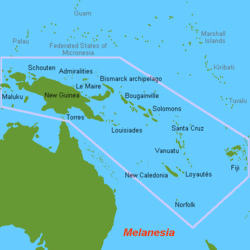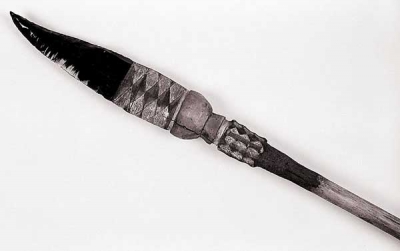Spear with obsidian head (1900.55.463)
 VanuatuSpear with obsidian head from the Admiralty Islands, Oceania. Collected by Norman Hardy. Given to the Museum by Robert Willkins in 1900.
VanuatuSpear with obsidian head from the Admiralty Islands, Oceania. Collected by Norman Hardy. Given to the Museum by Robert Willkins in 1900.
Obsidian is a naturally occurring glass formed as an extrusive igneous rock from rapidly-frozen lava. The Bismarck Archipelago, off the north-east coast of Papua New Guinea, is a rich natural resource of obsidian; in particular, the islands of Lou and Manus in the Admiralties from where the obsidian blade of this spear was probably resourced.
Obsidian has been used for projectile points since ancient times. This is due to its lack of crystal structure, which gives the blade edges an almost molecular thinness. Even today, well-crafted obsidian blades are used in medical surgery since their cutting edge is many times sharper and finer than that of even high-quality surgical steel scalpels.
In this example, the obsidian blade is hafted into a carved wooden socket and bound with string-work, which is then painted. The wooden socket is also covered with Parinarium gum, with shells inlaid into it. It is one of the 650 items given to the Museum by Norman Hardy in 1900 after a lifetime of collecting. From the beginning of the 20th century, the quality of manufacture of Melanesian obsidian-bladed spears and daggers decreased as they were replaced by imported European arms and became primarily items of tourist art. Fortunately, the fine workmanship of this spear indicates that it is a late example of a true, functional fighting spear.





